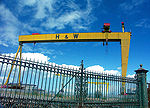Portal:Ireland/Selected article archive/14
Harland and Wolff Heavy Industries is a heavy industries and shipbuilders located in Belfast, Northern Ireland. Formed in 1861 by Edward James Harland (1831–1895) and Hamburg-born Gustav Wilhelm Wolff (1834–1913, in the UK from age 14), Harland had bought the small shipyard on Queen's Island, in which he was employed as general manager in 1858. The shipyard has built many types of ships continuously since then, the most famous being the RMS Titanic. Their main business today is ship repair and conversion work, ship design and bridge building. Harland and Wolff also owns the world's largest dry dock, which is in Belfast. Belfast's skyline is still dominated today by Harland and Wolff's famous twin cranes Samson and Goliath, built in 1974 and 1969 respectively.
The company was nationalised in 1977 but subsequently bought back from the British government in 1989 in a management/employee buy-out in partnership with the Norwegian shipping magnate Fred Olsen, leading to a new company called Harland and Wolff Holdings Plc. Faced with competitive pressures (especially as regards shipbuilding), Harland and Wolff have sought to shift and broaden their portfolio, focus less on shipbuilding and more on design and structural engineering, as well as ship repair, offshore construction projects and competing for other projects to do with metal engineering and construction. This led to Harland and Wolff constructing a series of bridges in Britain and also in the Republic of Ireland. Read more...

